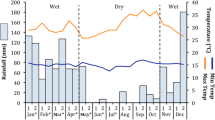Abstract
The movement patterns of two chacma baboon troops in the Drakensberg mountains of South Africa were studied over an 18-month period. One of these troops (HIGH) lived on the escarpment slopes (1920–2980 m), while the other (LOW) lived primarily in the montane belt (1560–2000 m). In this paper we analyze the effects of environmental variables on day journeys and home range use. We found the troops to be similar in the temporal patterning of their daily movement, in the resistance of travel speed to variations in local climatic conditions, and in their response to the nutritional bottleneck at the end of the austral winter. While both troops traveled farther as food became scarcer, HIGH troop undertook longer day journeys than LOW troop. This was probably due to the interactive effects of absolutely lower food availability and lower ambient temperatures. HIGH troop traveled farther when food was scarcer and when minimum temperatures were higher. Neither variable accounted for variance in the day journeys of LOW troop. Both troops used some areas of their home ranges preferentially. For LOW troop this preference followed the spatial distribution of food. While the same was generally true for HIGH troop, its home range use was complicated by the adverse temperatures of winter and spring. It abandoned the higher, more productive part of its range once temperatures became severe, returning only after minimum ground temperatures had risen above 0°C. These usage patterns differ from those described for eastern African baboon populations and reflect both the severity and sesonality of climate and the poor quality and extreme dispersion of food that characterize these southern mountains.
Similar content being viewed by others
References
Altmann, S. A., and Altmann, J. (1970).Baboon Ecology, University of Chicago Press, Chicago.
Anderson, C. M. (1982). Baboons below the Tropic of Capricorn.J. Hum. Evol. 11: 205–217.
Barton, R. A., Whiten, A., Byrne, R. W., and Strum S. C. (1992). Habitat use and resource availability in baboons.Anim. Behav. (in press).
Brain, C. (1988). Water gathering by baboons in the Namib desert.S. Afr. J. Sci 84: 590–591.
Byrne, R. W., Whiten, A., and Henzi, S. P. (1990). Measuring the food constraints on mountain baboons. In Thiago de Mello, M., Whiten, A., and Byrne, R. W. (eds.),Baboons: Behavior and Ecology, Use and Care. Selected Proceedings of the XIIth Congress of the International Primatological Society, University of Brasilia, Brazil, pp. 105–122.
Cable, C. (1984). Economy and technology in the Late Stone Age of southern Natal.BAR Int. Ser. 20.
Carter, P. L. (1971). Late Stone Age exploitation patterns in southern Natal.S. Afr. Archeol. Bull. 25: 55–58.
Chapman, C. A., Chapman, L. J., and McLaughlin, R. L. (1989). Multiple central place foraging by spider monkeys: Travel consequences of using many sites.Oecologia 79: 506–511.
Dunbar, R. I. M. (1988).Primate Social Systems, Croom Helm, London.
Dunbar, R. I. M., and Dunbar, E. P. (1974). Ecological relations and niche separation between sympatric terrestrial primates in Ethiopia.Folia Primatol. 21: 36–60.
Harding, R. S. O. (1976). Ranging patterns of a troop of baboons in Kenya.Folia Primatol. 25: 143–185.
Henzi, S. P., Dyson, M. L., and Deenik, A. (1990). The relationship between altitude and group size in mountain baboons (Papio cynocephalus ursinus).Int. J. Primatol. 11: 319–325.
Iwamoto, T., and Dunbar, R. I. M. (1983). Thermoregulation, habitat quality and the behavioral ecology of gelada baboons.J. Anim. Ecol. 52: 357–366.
Killick, D. J. B. (1963). An account of the plant ecology of the Cathedral Peak area of the Natal Drakensberg,Bot. Surv. S. Afr. Mem. No. 34, Government Printer, Pretoria.
Kummer, H. (1968).Social Organization of Hamadryas Baboons: A Field Study. University of Chicago Press, Chicago.
Post, D. G. (1982). Feeding behavior of yellow baboons (Papio cynocephalus) in the Amboseli National Park, Kenya.Int. J. Primatol. 3: 403–430.
Rasmussen, D. R. (1979). Correlates of patterns of range use of a troop of yellow baboons (Papio cynocephalus). I. Sleeping sites, impregnable females, births and male emigrations and immigrations.Anim. Behav. 27: 1098–1112.
Scotcher, J. S. b. (1982).Interrelations of Vegetation and Eland (Taurotragus oryxPallas)in Giant's Castle Game Reserve, Natal, Ph.D. thesis, University of the Witwatersrand.
Sharman, M. (1981).Feeding, Ranging, and Social Organization of the Guinea Baboon, Ph.D. thesis, University of St. Andrews.
Sigg, H., and Stolba, A. (1981). Home range and daily march in a hamadryas baboon troop.Folia Primatol. 36: 40–75.
Speakman, J. R. (1986). The optimum search speed of terrestrial predators when feeding on sedentary prey: A predictive model.J. Theor. Biol. 122: 401–407.
Stolz, L. P., and Saayman, G. S. (1970). Ecology and behavior of baboons in the northern Transvaal.Ann. Transvaal Mus. 26: 99–143.
Tyson, P. D., Preston-Whyte, R. A., and Schulze, R. E. (1976).The Climate of the Drakensberg, Report No. 31, Natal Town and Regional Planning Commission, Pietermarizburg, South Africa.
Whiten, A., Byrne, R. W., and Henzi, S. P. (1987). The behavioral ecology of mountain baboons.Int. J. Primatol. 8: 367–388.
Author information
Authors and Affiliations
Rights and permissions
About this article
Cite this article
Henzi, S.P., Byrne, R.W. & Whiten, A. Patterns of movement by baboons in the Drakensberg mountains: Primary responses to the environment. International Journal of Primatology 13, 601–629 (1992). https://doi.org/10.1007/BF02551256
Received:
Accepted:
Issue Date:
DOI: https://doi.org/10.1007/BF02551256




